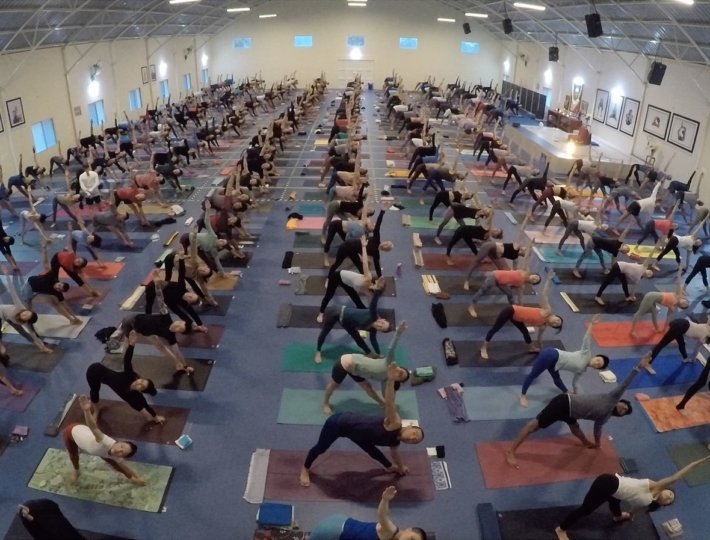Moving the body is important in Ayurveda. So important, in fact, that it’s included in the essential daily routine that has been enumerated in all the classic literature of Ayurveda. All of those texts firmly state that everyone should exercise on a daily basis, although they don’t mention what type of fitness it should be. That means people are free to choose what they enjoy.
In the sequence of the daily routine, exercise comes after anointing one’s body with oil. One place where we see this practice is a traditional Indian martial arts form called Kalaripayattu, which is practiced in Kerala. The reasoning behind this is that when you anoint your body with oil, there’s more flexibility, which results in fewer injuries.
Even if you’re not willing to oil up before each workout, there are some key takeaways from Ayurveda’s approach to exercise that all active people can learn from.
The Myriad Benefits of Exercise
The first thing Ayurveda says is that exercise makes the body feel light, and can help a person be enthusiastic about the day’s activities. Though exercise is a physical pursuit, Ayurveda acknowledges that it has an impact on the mind and aids in psychological balance. Secondly, the classical texts say that exercise helps muscle tissue in the body become more toned, which, these days, is one of the main motivators to hit the gym for some people.
Exercise also helps people achieve a compact body, so that muscle mass is proportionate to body fat. Ayurveda says this allows people to experience some physical strain without fatigue. So for example, carrying something heavy—such as laundry, groceries or a toddler—or doing some physical labor during the day won’t tucker you out if you’re fit. Exercise also helps burn fat. Ayurveda considers sweat to be the waste product of fat tissue, so the idea is that when you sweat, excess fat gets metabolized and is excreted from the body in the form of sweat.
Regular exercising also aids in efficient digestion of food, absorption of nutrients, and excretion of wastes. Plus, it boosts metabolism in all the tissues of the body. Lastly, and most importantly, exercise allows the body energies, called doshas, to work in their physiological states in a way that does not aggravate or cause imbalances in the body. As a result, people who exercise tend to feel more balanced.
Related: The Unique Release of an Emotionally Cathartic Workout
The Importance of Not Overdoing It
Even thousands of years of ago, Ayurvedic practitioners recognized that people could become addicted to—or at least over-enthusiastic about—exercise. Here’s how they explained it: A person’s strength can be compared to a roaring lion, and exercise is like an elephant. If the two confront each other, the lion will kill the elephant with great difficulty, but the lion will also probably die because of exhaustion.
What they’re saying here is that people can exert themselves to an extremely high degree, but it’s not always worth it to push yourself past your limits. If you do too much, instead of just being toned and having a good bodily enthusiasm, you may become exhausted, and exhaustion can result in disease. In Western medicine, this is called Overtraining Syndrome, which can lead to a weakened immune system, among other ailments. In other words, just because you can do something doesn’t mean you should.
So how much exercise is ideal? If you have an idea of what your maximum output for exercise is, your regular daily exercise should be at half of that amount. For example, if you know you can run continuously for one hour, you should run for a half hour only. If you go beyond that point, you are dipping into the body’s vitality rather than helping the body to become active and strong.
If you’re not sure what your maximum is for your chosen form of exercise, there’s a physical way that you can measure this, too. If you’re sweating on your chest, back, forehead, and nose, then you’ve reached the threshold point where you should slow down and stop exercising. Also, a constant need to breathe through the mouth instead of the nose indicates that you need to slow down or stop.
Exercise According to Season and Energy
Like eating, exercise is also done with consideration for the season in Ayurveda. Colder seasons and climates allow for more exercise. In hotter weather, the intensity of exercise should be moderated because the external environment is causing the body to lose fluids. Doing vigorous exercise can further dehydrate you and cause tissue depletion, so it’s especially crucial not to overdo it when it’s hot outside.
When it comes to body type, there are also some guidelines. Kapha (water) types have the most endurance. They are best-suited to intense exercise, and Ayurveda encourages them to do it because even though they have great athletic capability, they are often less motivated to move. Vata (wind) types should do the least amount of exercise because they have less lubrication in their joints and their muscles aren’t naturally as strong. It’s better for them to not overstrain themselves. Pitta (fire) types fall somewhere in the middle. For example, let’s say a kapha should do 40 push-ups for optimal health, a pitta would do 30, and a vata would do 20. (Related: Learn more about body types here!)
Similarly, there’s a reason why exercise is recommended in the morning. The day is divided into three phases. The first phase of the day is the kapha phase, the second is pitta, and the third is vata. You want to exercise when you have the most strength and endurance, and that’s in the beginning or kapha part of the day. Of course, it’s not wrong to exercise in the evening and you’ll certainly still see some benefits, but according to Ayurveda, a daily morning workout of moderate intensity is one of the best things you can do to achieve optimal health.








Comments (0)